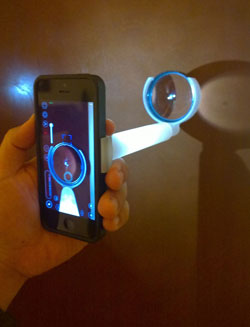Now Smartphones Can Be Used To Diagnose Eye Problems
Recently, mobile devices and some accessories have been developed to keep track of our health. But these products gives only general measurements of health like heart-rate, blood pressure or calories burned. Researchers from Stanford University School of Medicine have developed an adapter for smartphones that will help smartphone to take high resolution pictures of front and back of the eye.
Robert Chang, assistant professor at Stanford and one of the developers of this adapter explains that, with the help of this product, a person with less practice can take the picture of eyes and share it securely with their health practitioner and store it in patient’s electronic record. Since, these adapters are developed for smartphones, it will increase the eye-care services and patient can get advice from doctors remotely. Lead author of this research David Myung believes, adapting smartphones can revolutionize the delivery of eye-care where ophthalmologists aren't readily available.

In today’s world, smartphones have both the qualities that this research needs - A good quality camera and the facility of sharing something securely through internet, in our case, high resolution pictures of eyes to medical records. At first, adapters were attached to a smartphone with a slit lamp, a microscope with a high intensity light source to capture pictures of front of the eye. But this method was inconvenient and time consuming. Robert Chang started concentrating on pocket-sized adapters to reduce the inconvenience of the previous method. After successfully imaging the front of the eye with new method(By pocket-sized adapter), they focused on the imaging of back of the eye (Retina). To capture pictures of retina, it needs a focused light to reach inside the pupil.
David Myung used optics theory to determine the perfect working distance and lighting condition to connect, an examination lens to a phone with the help of a small adapter. After hundreds of iterations, they got the perfect result. Moving on to the availability, these adapters would be available only for research purposes, initially. Robert Chang says, the production cost of this adapters is 90 dollars and they are trying to reduce it further. What do you think about getting your eyes checked through your smartphone? Share with us through your comments.
Source: #-Link-Snipped-#
Robert Chang, assistant professor at Stanford and one of the developers of this adapter explains that, with the help of this product, a person with less practice can take the picture of eyes and share it securely with their health practitioner and store it in patient’s electronic record. Since, these adapters are developed for smartphones, it will increase the eye-care services and patient can get advice from doctors remotely. Lead author of this research David Myung believes, adapting smartphones can revolutionize the delivery of eye-care where ophthalmologists aren't readily available.

In today’s world, smartphones have both the qualities that this research needs - A good quality camera and the facility of sharing something securely through internet, in our case, high resolution pictures of eyes to medical records. At first, adapters were attached to a smartphone with a slit lamp, a microscope with a high intensity light source to capture pictures of front of the eye. But this method was inconvenient and time consuming. Robert Chang started concentrating on pocket-sized adapters to reduce the inconvenience of the previous method. After successfully imaging the front of the eye with new method(By pocket-sized adapter), they focused on the imaging of back of the eye (Retina). To capture pictures of retina, it needs a focused light to reach inside the pupil.
David Myung used optics theory to determine the perfect working distance and lighting condition to connect, an examination lens to a phone with the help of a small adapter. After hundreds of iterations, they got the perfect result. Moving on to the availability, these adapters would be available only for research purposes, initially. Robert Chang says, the production cost of this adapters is 90 dollars and they are trying to reduce it further. What do you think about getting your eyes checked through your smartphone? Share with us through your comments.
Source: #-Link-Snipped-#
0
